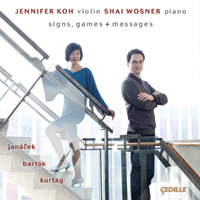
Available from Cedille Records
Audiophile Audition
By Gary Lemco
December 18, 2013
original
link
Jennifer Koh and Shai Wosner explore the wages of folk music when it meets, headlong, the experimental genius of three Slavic composers.
Signs, Games + Messages = JANACEK: Sonata for Violin and Piano; KURTAG: Doina; The Carenza Jig; Tre Pezzi for Biolni and Piano, Op. 14e; Fundamental No. 2; In memoriam Blum Tamas; Like the flowers of the field; Postcard to Anna Keller; A Hungarian Lesson for Foreigners; Fanfare to Judit Maros’ wedding; Les Adieux; In Nomine – all’ongherese; BARTOK: First Sonata for Violin and Oiano – Jennifer Koh, violin/ Shai Wosner, p. – Cedille CDR 90000 143, 76:15 (9/24/13) [Distr. by Naxos] ****:
The adventurous violin virtuoso Jennifer Koh and pianist Shai Wosner (rec. 27-28 April 2012) have conjured a recital that “inhabits two worlds: the influence of folklore. . .and the composer’s striking originality. . .to create a program that explores these intertwined strands. . .the tension between the visionary modernism. . .and the visceral pull of folk and cultural memory that is so essential to the language of these composers.”
Koh and Wosner open with Leos Janacek’s glowing Violin Sonata (1922), a piece that oscillates between D-flat Major and B-flat Minor in its first movement, composed of fragments and melodic impulses saturated in shifting rhythmic kernels. The E Major Ballada: Con moto soars in dreamy ecstasy in a more romantic manner than the first movement, and speculation has it that this movement was conceived earlier, c. 1908. The Allegretto appeals to the percussive Moravian elements endemic in Janacek: it opens in pounding 2/4 then transitions to a declamatory, hazy middle section in ¾. Wosner’s piano part enjoys a volatile bravura, often expressed in sliding, cembalom sonorities. The last movement returns, Adagio, to the evolution of emotional, impulsive fragments that move in half steps, augmented fourths, and minor sixth chords, a moody, jarring alchemy. The last pages return to the movement’s opening, bittersweet, adagio et pianissimo.
Hungarian composer Gyoergy Kurtag (b. 1926) has created eight volumes of Jatekok (“Games”) since 1973. Highly pulverized in the manner of Webern, the pieces seek the musical experience as atomic gesture, a kind of Platonic essence. Doina for piano solo is marked parlando con moto, a clash of minor seconds, like B against B-flat. If the music nods to Bartok and klezmer, it has become too compressed to claim national or ethnic origins. The Carenza Jig is for violin solo and last barely 50 seconds. A kind of caprice, it moves by major fifths in double stops, plucked strings and arco, following – G, D, A, E – the instrument’s open strings. The same formula applies to the first of Tre Pezzi, Op. 14e, except the violin plays in C Major over Wosner’s five sharps in B. Vivo leaps in both parts, by intervals and dynamically. Aus der Ferne (“From far away”) sounds like the last gasps in half-step chromatics of a tubercular patient or maybe the dying Kurtz in Heart of Darkness.
The eight pieces that follow prove experimental and caustic in their intricacies and witty sound effects. Fundamentals 2 for wordless voice and piano has Koh sigh and huff over distinct piano tones. In Memoriam Blum Tamas wants varied tones from double-stopped notes, a melancholy etude quite discordant on its own terms. Wosner has his hands full with Like the flowers of the field, marked legatissimo possible, rife with sustained major and minor seconds played smoothly and softly. Koh plays a brief cluster of double-stop tones called Postcard to Anna Keller that lasts 30 seconds, more a postage stamp than a letter. A Hungarian Lesson pairs the voices of our principals against ten strikes on the keyboard, so it sounds like angry responses to having been dealt bad cards. The Fanfare to Judit Maros’ wedding almost sounds like Mussorgsky but more brash, in ffff and vivacissimo. Les Adieux exploits some of the same harmonic group as Beethoven’s Op. 81a, but it takes a more Janacek turn or two by juxtaposing major sixths and minor sevenths played dolce and quasi in songo – sweetly, in the manner of a dream. In Nomine opens like Ravel’s Tzigane, but it combines a liturgical ethos with alternating diatonic and chromatic passagework for Koh’s intensely lyrical violin.
Bartok’s 1922 First Violin Sonata provides many an agile, leaping or astonishingly bravura moment for both players, neither of whom seem to occupy the other’s musical universe. If the piece lies in C-sharp Minor, it pays little heed to its imperatives, moving through pentatonic scales and the whole-tone precedents set by Debussy. Koh and Wosner capture the dizzy, improvisational ardor of the work, whose spatial objectives in the opening Allegro Appassionato rival Beethoven’s Kreutzer Sonata, a Bartok favorite. The Adagio in F-sharp Minor exploits the tritone, a device Bartok admired in Liszt. The meditative, disturbing music – rife with recollections from late Beethoven quartets – later evolves into a rustic drone pattern in the piano under an agitated Jennifer Koh. Something of Liszt again for the last movement – here, Mephisto – bringing in Koh on the low G string and then exploding into a devilish dance that will not quit. The impression of a demented banshee suits performers and composer, and the keyboard contributes its own brand of manic emotions. If these sounds reflect the late-night strums of rhapsodic folk music, don’t forget a generous tip for their bold playing.
Copyright ©2013 Audiophile Audition